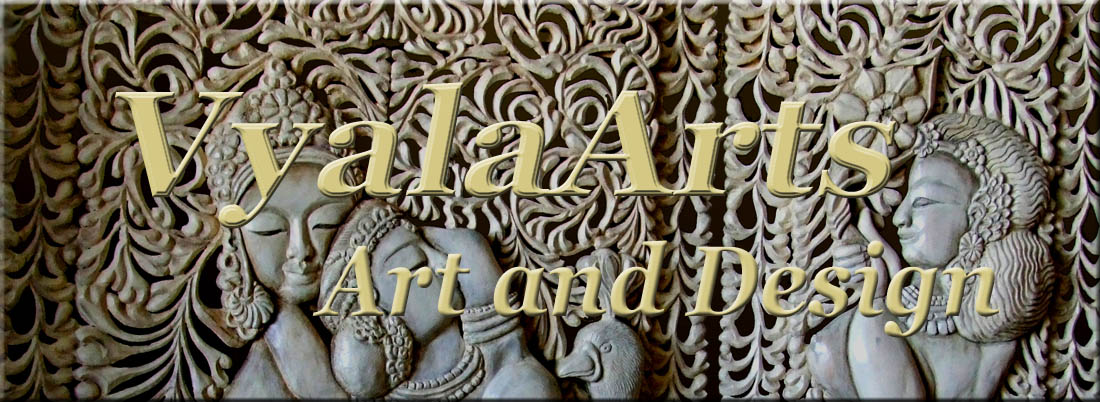This is another piece from the
Magic Symbols series, a series about the icons and secrets of ancient cultures. The silk painting was called
Mesopotamia:
"Mesopotamia"
40" x 13"
silk, stitched
Ancient cultures are tremendously fascinating, specifically when they keep their secrets, when no-one has been able yet to decipher them. This leaves enough space for speculation and theories. The less is really known about an ancient culture the more it incites curiosity of course, especially when precious treasures might be involved which could be very attractive for public and media and thus a valid argument to fork out new research grants.
Now we are talking about Mesopotamia – the land between Tigris and the Euphrates river. A while ago we heard something about the axis of evil, now we hear about the axis of chaos. The land between the Tigris and the Euphrates yet was also the axis of human culture from where civilization was brought into the adjacent regions. The ancient empire of Mesopotamia even once included parts of the Mediterranean sea, conquered by King Sargon who founded the city of Akkad. Doesn’t it seem a bit paradox that we are talking about the very same countries here which are now called Irak and Iran?
More than 5000 years ago, the southern part of the land between the rivers was only marsh land. No rock, no metal, nor hard woods for constructions could be found there, but nevertheless here was the cradle of the earliest advanced culture: the land of Sumer. Sumerian cities and temples were embellished with gold, silver and precious stones which were organized through long-distance trade.
Sumerian culture was a mix of foreign and local elements. The Sumerians were highly innovative people, creative in their response to the natural challenges of the two rivers and their immense flooding each year. Many of the great Sumerian legacies, such as writing, irrigation, the wheel, astronomy and literature, can be seen as adaptive responses to the great rivers. And now, today?
These formerly highly developed countries disappear in clouds of utter poverty of the population due to religious power plays. How is it possible that civilizations with greatly evolved societies fall back into medieval habits? Shouldn’t this be a warning for any civilization which starts to neglect freedom and tolerance?
(image source: http://www.garone.net/tony/disc.html)
.
“The Sumerians were the first people known to have
devised a scheme of written representation as a means of communication.
From the earliest writings, which were pictograms (simplified pictures
on clay tablets), the Sumerians gradually created cuneiform–a way of
arranging impressions stamped on clay by the wedge-like section of a
chopped-off reed. The use of combinations of the same basic wedge shape
to stand for phonetic, and possibly for syllabic, elements provided more
flexible communication than the pictogram. Through writing, the
Sumerians were able to pass on complex agricultural techniques to
successive generations; this led to marked improvements in agricultural
production.
Another important Sumerian legacy was the recording of
literature. The most famous Sumerian epic and the one that has survived
in the most nearly complete form is the epic of Gilgamesh. The story of
Gilgamesh, who actually was king of the city-state of Uruk in
approximately 2700 B.C., is a moving story of the ruler’s deep sorrow at
the death of his friend and of his consequent search for immortality.
Other central themes of the story are a devastating flood and the
tenuous nature of man’s existence. Laden with complex abstractions and
emotional expressions, the epic of Gilgamesh reflects the intellectual
sophistication of the Sumerians, and it has served as the prototype for
all Near Eastern inundation stories.” (Excerpted from Iraq: A
Country Study. Helen Chapin Metz, ed. Washington, DC: Federal Research
Division of the Library of Congress, 1988).
This may explain why the name of “Mesopotamia” seems to be connected
with so many myths and secrets as well as with the Bible. Kings such as
Nebukadnezar and Sanherib, cities such as Ur, Ninive, Assur and Babylon
are all to be found in Mesopotamia.
But the Bible tells only a
tiny part of Mesopotamia’s history and soon the people of Sumer sank
into oblivion, until the oldest tablets (dating from ca. 3500 bc) were
found in Kisch (see map). The typical cuneiform was developed much
later, around 2700 BC.
It took another 4500 years until the tablets could be deciphered by a German philologist in 1802, by Georg Friedrich Grotefend.
.
But Mesopotamia possessed even more superlatives. It was probably the
land with the oldest tree-of-life symbols. Since nearly 5000 years and
in probably every society the tree was the symbol for life itself. The
tree did not only deliver construction material for houses and all kinds
of containers, but it was also needed for the supply of food, for
transportation and many other requirements. All bigger civilizations
such as Sumerians, Assyrian, Egyptians and Chinese, Greeks and Romans
would not have developed without their forests!
The
tree as a symbol for life had an additional meaning: in every country on
this world the tree was always the link between heaven and earth. While
its roots went deep into the soil and its branches reached high into
the sky humans considered this as the tie between the two plains. All
the known myths are talking about this and so it even seems to be the
band that all humans are connected through.
~~~~




























































